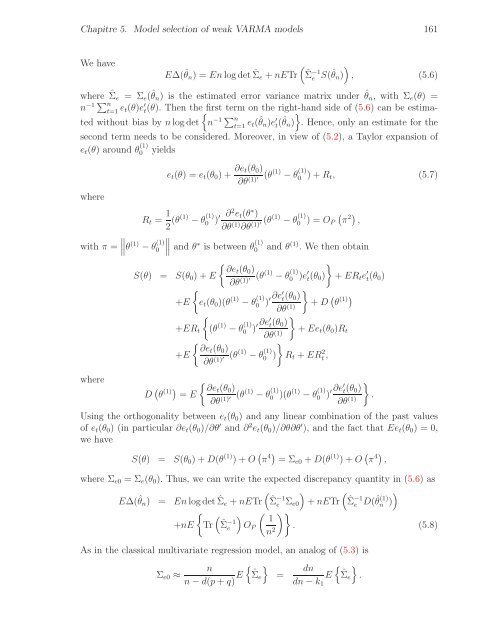THÈSE Estimation, validation et identification des modèles ARMA ...
THÈSE Estimation, validation et identification des modèles ARMA ...
THÈSE Estimation, validation et identification des modèles ARMA ...
Create successful ePaper yourself
Turn your PDF publications into a flip-book with our unique Google optimized e-Paper software.
Chapitre 5. Model selection of weak V<strong>ARMA</strong> models 161<br />
We have<br />
E∆( ˆ θn) = Enlogd<strong>et</strong> ˆ <br />
Σe +nETr ˆΣ −1<br />
e S(ˆ <br />
θn) , (5.6)<br />
where ˆ Σe = Σe( ˆ θn) is the estimated error variance matrix under ˆ θn, with Σe(θ) =<br />
n−1n t=1<strong>et</strong>(θ)e ′ t (θ). Then the<br />
<br />
first term on the right-hand side of (5.6) can be estimated<br />
without bias by nlogd<strong>et</strong> n−1n t=1<strong>et</strong>( ˆ θn)e ′ t (ˆ <br />
θn) . Hence, only an estimate for the<br />
second term needs to be considered. Moreover, in view of (5.2), a Taylor expansion of<br />
<strong>et</strong>(θ) around θ (1)<br />
0 yields<br />
where<br />
<strong>et</strong>(θ) = <strong>et</strong>(θ0)+ ∂<strong>et</strong>(θ0)<br />
∂θ (1)′ (θ (1) −θ (1)<br />
0 )+Rt, (5.7)<br />
Rt = 1<br />
2 (θ(1) −θ (1)<br />
0 )′ ∂2<strong>et</strong>(θ∗ )<br />
∂θ (1) ∂θ (1)′(θ (1) −θ (1) 2<br />
0 ) = OP π ,<br />
<br />
<br />
with π = θ (1) −θ (1)<br />
<br />
<br />
and θ∗ is b<strong>et</strong>ween θ (1)<br />
where<br />
0<br />
0 and θ (1) . We then obtain<br />
<br />
∂<strong>et</strong>(θ0)<br />
S(θ) = S(θ0)+E<br />
∂θ (1)′ (θ (1) −θ (1)<br />
0 )e′ t (θ0)<br />
<br />
<br />
+E <strong>et</strong>(θ0)(θ (1) −θ (1)<br />
0 ) ′∂e′ t (θ0)<br />
∂θ (1)<br />
<br />
+D θ (1)<br />
<br />
+ERt (θ (1) −θ (1)<br />
0 )′∂e′ t(θ0)<br />
∂θ (1)<br />
<br />
+E<strong>et</strong>(θ0)Rt<br />
<br />
∂<strong>et</strong>(θ0)<br />
+E<br />
∂θ (1)′ (θ (1) −θ (1)<br />
0 )<br />
<br />
Rt +ER 2 t ,<br />
D θ (1) = E<br />
+ERte ′ t (θ0)<br />
<br />
∂<strong>et</strong>(θ0)<br />
∂θ (1)′ (θ (1) −θ (1)<br />
0 )(θ (1) −θ (1)<br />
0 ) ′∂e′ t(θ0)<br />
∂θ (1)<br />
<br />
.<br />
Using the orthogonality b<strong>et</strong>ween <strong>et</strong>(θ0) and any linear combination of the past values<br />
of <strong>et</strong>(θ0) (in particular ∂<strong>et</strong>(θ0)/∂θ ′ and ∂ 2 <strong>et</strong>(θ0)/∂θ∂θ ′ ), and the fact that E<strong>et</strong>(θ0) = 0,<br />
we have<br />
S(θ) = S(θ0)+D(θ (1) )+O π 4 = Σe0 +D(θ (1) )+O π 4 ,<br />
where Σe0 = Σe(θ0). Thus, we can write the expected discrepancy quantity in (5.6) as<br />
E∆( ˆ θn) = Enlogd<strong>et</strong> ˆ <br />
Σe +nETr ˆΣ −1<br />
e Σe0<br />
<br />
+nETr ˆΣ −1<br />
e D(ˆ θ (1)<br />
n )<br />
<br />
<br />
+nE Tr ˆΣ −1 1<br />
e OP<br />
n2 <br />
. (5.8)<br />
As in the classical multivariate regression model, an analog of (5.3) is<br />
Σe0 ≈<br />
n<br />
n−d(p+q) E<br />
<br />
ˆΣe<br />
=<br />
dn<br />
E<br />
dn−k1<br />
ˆΣe<br />
<br />
.
















